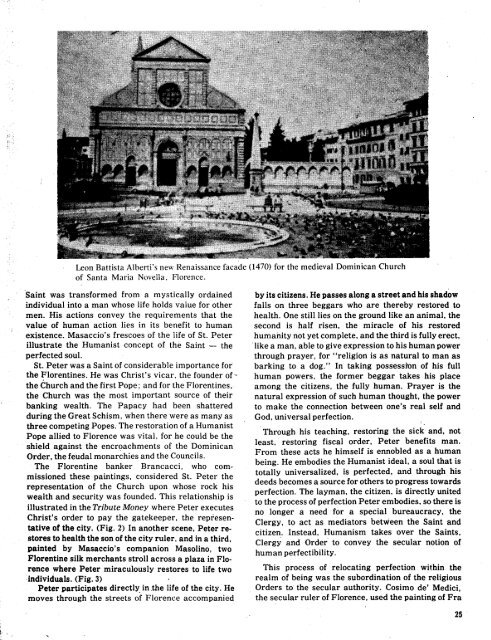Renaissance and
Renaissance and
Renaissance and
You also want an ePaper? Increase the reach of your titles
YUMPU automatically turns print PDFs into web optimized ePapers that Google loves.
Leon Battista Alberti's new <strong>Renaissance</strong> facade (1470) for the medieval Dominican Church<br />
of Santa Maria Novella, Florence.<br />
Saint was transformed from a mystically ordained by its citizens. He passes along a street <strong>and</strong> his shadow<br />
individual into a man whose life holds value for other falls on three beggars who are thereby restored to<br />
men. His actions convey the requirements that the health. One still lies on the ground like an animal, the<br />
value of human action lies in its benefit to human second is half risen, the miracle of his restored<br />
existence. Masaccio's frescoes of the life of St. Peter humanity not yet complete, <strong>and</strong> the third is fully erect,<br />
illustrate the Humanist concept of the Saint -- the like a man, able to give expression to his human power<br />
perfected soul. through prayer, for "religion is as natural to man as<br />
St. Peter was a Saint of considerable importance for barking to a dog." In taking possession of his full<br />
the Florentines. He was Christ's vicar, the founder of _ human powers, the former beggar takes his place<br />
the Church <strong>and</strong> the first Pope; <strong>and</strong> for the Florentines, among the citizens, the fully human. Prayer is the<br />
the Church was the most important source of their natural expression of such human thought, the power<br />
banking wealth. The Papacy had been shattered to make the connection between one's real self <strong>and</strong><br />
during the Great Schism, when there were as many as God, universal perfection.<br />
three competing Popes. The restoration of a Humanist '"<br />
Pope allied to Florence was vital, for he could be the Through his teaching, restoring the sick <strong>and</strong>, not<br />
shield against the encroachments of the Dominican least, restoring fiscal order, Peter benefits man.<br />
Order, the feudal monarchies <strong>and</strong> the Councils. From these acts he himself is ennobled as a human<br />
being. He embodies the Humanist ideal, a soul that is<br />
The Florentine banker Brancacci, who com.<br />
missioned these paintings, considered St. Peter the totally universalized, is perfected, <strong>and</strong> through his<br />
deeds becomes a source for others to progress towards<br />
representation of the Church upon whose rock his<br />
wealth <strong>and</strong> security was founded. This relationship is perfection. The layman, the citizen, is directly united<br />
to the process of perfection Peter embodies, so there is<br />
illustrated in the Tribute Money where Peter executes<br />
no longer a need for a special bureaucracy, the<br />
Christ's order to pay the gatekeeper, the represen- Clergy, to act as mediators between the Saint <strong>and</strong><br />
tative of the city. (Fig. 2) In another scene, Peter re- citizen. Instead, Humanism takes over the Saints,<br />
stores to health the son of the city ruler, <strong>and</strong> in a third, Clergy <strong>and</strong> Order to convey the secular notion of<br />
painted by Masaccio's companion Masolino, two human perfectibility.<br />
Florentine silk merchants stroll across a plaza in Florence<br />
where Peter miraculously restores to life two This process of relocating perfection within the<br />
4ndividuals. (Fig. 3) realm of being was the subordination of the religious<br />
Peterparticipatesdirectly.in the lifeofthecity.He Orders to the secularauthority.Cosimo de'Medici,<br />
moves through the streetsof Florence accompanied the secularrulerofFlorence,used thepaintingofFra<br />
25

















